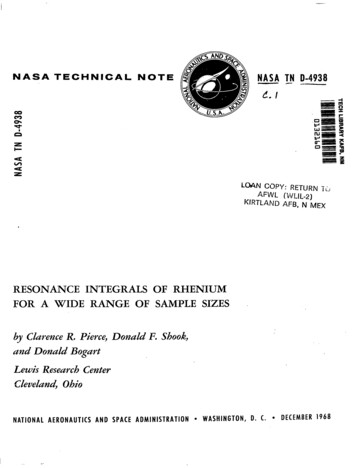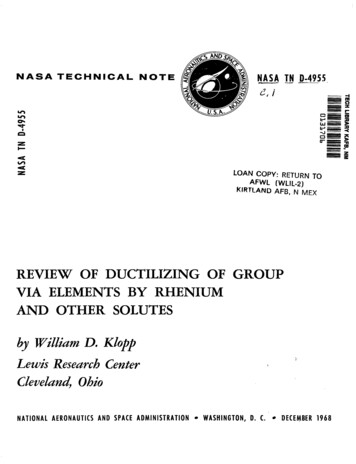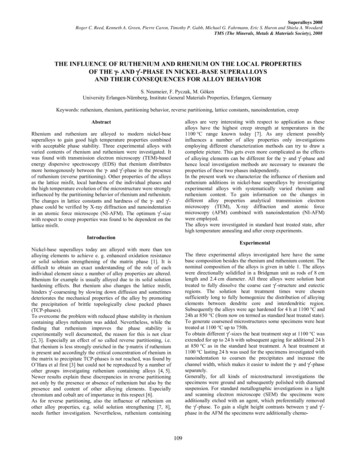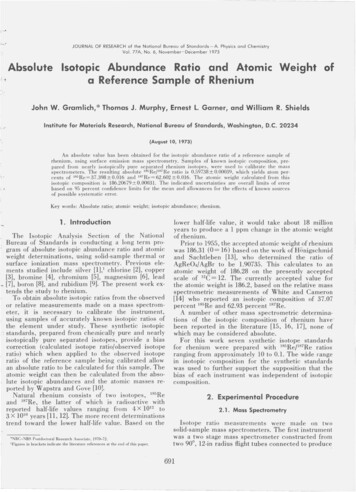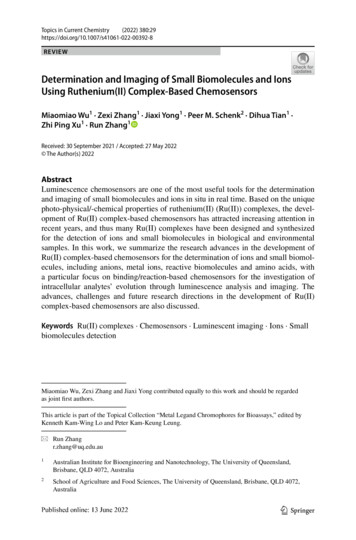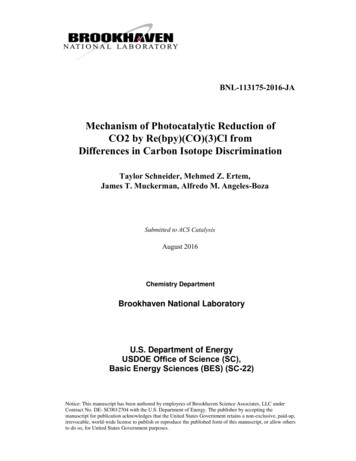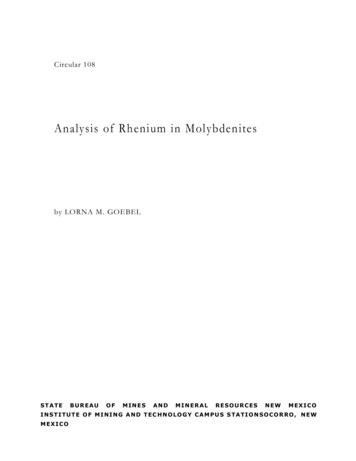
Transcription
Circular 108Analysis of Rhenium in Molybdenitesby LORNA M. COINSTITUTE OF MINING AND TEC HNOLOGY CAMPUS STATION SOCORRO, NEWMEXICO
THE NEW MEXICO BUREAU OF MINES AND MINERAL RESOURCES DonH. Baker, Jr., DirectorFull-Time StaffJOYCE M. AGUILAR, StenographerWILLIAM L. HAWKS, Materials EngineerWILLIAM E. ARNOLD, Scientific IllustratorFRANK E. KOTTLOWSKI, Sr. Geol. & Ass't. Dir.ROSHAN B. BHAPPU, Senior Metallurgist (on lv.)ALEX. NICHOLSON, Geologist-EditorROBERT A. BIEBERMAN, Petroleum GeologistROBERT L. PRICE, DraftsmanLYNN A. BRANDVOLD, Assistant ChemistJACQUES R. RENAULT, GeologistELISE BROWER, Assistant Chemist (on lv.)JOHN W. SHOMAKER, GeologistRICHARD R. CHAVEZ, Lab. AssistantJACKIE H. SMITH, Lab. AssistantLois M. DEVLIN, Office ManagerMARILYNN SZYDLOWSKI, SecretaryJO DRAKE, Director's SecretaryROBERT H. WEBER, Senior GeologistROUSSEAU H. FLOWER, Senior PaleontologistSUE WILKS, TypistROY W. FOSTER, Petroleum GeologistMAX E. WILLARD, Economic GeologistJUARINE W. WOOLDRIDGE, Editorial ClerkPart-Time StaffRUFIE MONTOYA, Dup. Mach. Oper. JOHNK. ARNOLD, Editorial AssistantG u s B L A I S D E L L , P u b l i c R e l a t i o n s J A M E S REICHE, Instrument Manager RONALDROMAN, Research Metallurgist W. KELLYA. BRIERLEY, Ass't Prof. BiologySUMMERS, GeologistROBERT LEASE,FRANK B. TITUS, GeologistGeologistMARTHAGraduate StudentsELISE BROWER, GeochemistSAUL ESCALERA, MetallurgistWALTER W. FISHER, MetallurgistMARSHA KOEHN, GeologistCHE-CHEN LIU, MetallurgistWALTER H. PIERCE, GeologistHMA ROFFMAN, GeochemistDAVID A. SCHWAB, GeochemistPlus more than 35 undergraduate assistants
Circular 108Analysis of Rhenium in Molybdenitesby LORNA M. GOEBELA s s o c i a t e C u r a t o r, Co rp u s C h r i s t i M u s e um1970STATE BUREAU OF MINES AND MINERAL RESOURCES NEWMEXICO INSTITUTE OF MINING AND TECHNOLOGYCAMPUS STATIONSOCORRO, NEW MEXICO
NEW MEXICO INSTITUTE OF MINING & TECHNOLOGYStirling A. Colgate, PresidentSTATE BUREAU OF MINES AND MINERAL RESOURCESDon H. Baker, Jr., DirectorTHE R E G EN TSMEMBERS EX OFFICIOTHE HONORABLE DAVID F. CARGO . Governor of New MexicoLEONARD DELAYO . Superintendent of Public InstructionAPPOINTED MEMBERS.WILLIAM G. ABBOTT . HobbsHENRY S. BIRDSEYE . AlbuquerqueTHOMAS M. CRAMER . CarlsbadSTEVE S. TORRES, JR. . SocorroRICHARD M. ZIMMERLY . SocorroPublished May 1970For sale by the New Mexico Bureau of Mines & Mineral ResourcesCampus Station, Socorro, N. Mex. 87801 —Price 0, 50
A BS TR A C TCurrent procedures for the analysis of rhenium are based on separa tion methods that fail to isolate rhenium from interfering elements. Ofseveral analytical methods studied, calcining with calcium oxide, leachingwith a hot aqueous oxidizing solution, and spectrophotometrically determin ing the concentration of rhenium with a-furildioxime produces the most re liable results. Using this procedure, a sample of Arizona molybdenite con centrate was shown to contain 320 ppm rhenium with a 95 -percentconfidence interval of 10 ppm and a standard deviation of 4.97 percent;standard deviations as low as 0.79 percent were obtained on single runs offour or more replicates. Published standard deviations for conventionalanalyses of the same material average about 20 percent. Recovery of 90 to100 percent of added standards was obtained up to a total rhenium contentof 500 ppm for a 1 -g sample.1
INTRODUCTIONThe current (1969) procedures for the analysis of rhenium are basedon separation methods that do not completely isolate rhenium from interfer ing elements, especially molybdenum. Geilmann, Weigge, and Weibke (1932)devised the potassium thiocyanate -stannous chloride (KCNS-SnCl 2 ) spectrophotometric method, which, with some modifications, has been consideredthe best method for determining rhenium content.Lebedev (1962) reported that Suvorova, Burdokov, and Rashii calcinedmolybdenite concentrates with calcium oxide (CaO) to form calcium per rhenate(Ca[Re0 4 ] 2 ). If rhenium in molybdenite is assumed in the stoichio metric ratio ofReS 2 (L e bedev, 1962), then the roasting with calcium oxide is given by theequations:4 ReS 2 15 O 2 2 Re 2 0 7 8 S0 2andRe 2 O 7 CaO Ca(ReO 4 ) 2and the over-all reaction is4 ReS 2 2 CaO 15 O 2 2 Ca(ReO 4 ) 2 8 S0 2In the absence of excess oxygen, the sulfur dioxide will reduce theheptoxide to rhenium dioxide and rhenium trioxide. To prevent this, the use ofoxidizing agents mixed with the lime has been proposed; calcium nitrate(Tsyvina and Davidovich, 1960), potassium perchlorate (Peshkova, Ignat'eva,and Ozerova, 1963), and potassium permanganate (Nikolaeva and Stolyarova,1964) have been used in this respect.The solubility of calcium perrhenate dihydrate (Ca[ReO 4 ] 2 2 H 2 0) is227.8 g/100 ml of water at 30 C (Smith and Maxwell, 1951), whereas that ofcalcium molybdate (CaMoO 4 ) is only 0.0023 g/ 100 ml at 20 C (Siedell andLinke, 1952). At 1 atmosphere the dissociation pressure of calcium perrhen ate ranges from 0.03 mm Hg at 600 C to 0.157 mm Hg at 720 C. Hence, bycalcining a sample with calcium oxide (lime) and water -leaching the roastedcake, a quantitative separation of rhenium and molybdenum should beeffected. Tsyvina and Davidovich (1960), using radioactive rhenium -186 as atracer, reported up to 96 percent recovery with the calcium oxide roast at600 to 800 C. They and Peshkova, Ignat'eva, and Ozerova (1963) removedthe sulfate ion by precipitation with barium chloride. Nikolaeva and Stolya -2
rova (1964) re moved excess calcium ion by precipitation with ammoniumcarbonate. Using the se procedure s, rhenium may be effe ctively se paratedfrom the following ions that inte rfe re with a spectrophotome tric de termin ation: molybdenum, tungsten, calcium, cad mium, bismuth, antimony, mer cury, se lenium, te llurium, and arsenic.Of the many reagents that have been suggested for the spectrophotometric determination of rhenium, the two most widely used are thiocyanateion and a-furildioxime. Perrhenate ion, on red uction with stannous chlo ride,yields a reactive complex, ReO 2 C1 2 - 3 (Iordanov and Pavlova, 1967). Thereaction of perrhenate ion with a -furildioxime was first reported byPeshkova and Gromova (1952), who found that perrhenate, in the presenceof stannous chloride with a -furildioxime, forms solutions that are yelloworange, orange, or raspberry red, depending on the quantities of reagents.This suggests the formation of different complexes. The red compound isextractable with organic solvents and the res ulting solutions obey Beer'slaw. The maximum absorption is at 533 millimicrons, with a specific ab sorbance at 530 millimicrons of 3. 39x10 4 (Pollock and Zopatti, 1965). Me loche, Martin, and Webb (1957) were the first to publish a procedure usinga-furildioxime and reported that in the range of 0.4 to 6.0 ppm rhenium theabsorbance follows Beer's law with an average deviation of 0.2 percent(?). Touland Okác (1960) and Heaney and Malouf (1963) studied interferences andreported that bismuth, chromium, tungsten, vanadium, cupric molybdate, ar senite, arsenate, selenate, nitrate, and thiocyanate ions, noble metals, andoxidizing agents interfere. Molybdenum causes low values by forming color lesscompounds, but appears to be tolerated to a greater ext ent than in thethiocyanate method.In this investigation, published procedures for determination of rhe nium in molybdenum concentrates were reviewed and compared experimen tally, and an improved method was devised.A CK NO WL E DGM ENTSThe writer thanks the New Mexico State Bureau of Mines pport,encouragement, and advice of Roshan B. Bhappu and Dexter H. Reynolds,who served as supervisors, is appreciated. Robert L. Price is gra tefullyacknowledged for drafting the figures.3
EXPERIMENTAL PROCEDURESReagentsCalcium oxide, CaO, technical grade.Potassium permanganate, KMnO 4 , reagent grade, 1 -percent aqueous solu tion.Barium chloride, BaC1 2 , reagent grade, 0.5M aqueous solution.A mmon ium carb ona te , (NH 4 ) 2 CO 3 , 250 g in e no ugh 6 N NH4 OH to make 1lite r.a-furildioxime, (C4H3O C:NOH)2 2H2 O, C. P. grade, 0.7 g in 200 ml acetone, madefresh.Stannous chloride, SnCl 2 2H 2 0, reagent grade, 10 g dissolved in 10 ml concentrated hydrochloric acid diluted to 100 ml, made fresh.Ammonium perrhenate, NH 4ReO4, C. P. grade, 1,000 ppm aqueous stocksolution, diluted as needed.SamplesFour flotation concentrates of molybdenite, MoS, and one commer cial molybdenite reagent were used for standards aria' test materials, asfollows:A.B.C.D.E.F.G.Arizona molybdenite concentrate; rhenium content high. This samplewas used for comparative study of methods.New Mexico molybdenite concentrate; 10 ppm rhenium (Fle ischer, 1959).Colorado molybdenite concentrate; 5 to 28 ppm rhenium (Fleischer,1959).New Mexico molybdenite concentrate; 18 ppm rhenium (Fleischer, 1959).E. Arizona molybdenite concentrate; analysis not published.Southwestern United States molybdenite concentrate; 370 ppm rhenium (private,communication).Molybdenite reagent; Sargent Chemical Company, Lot SC 13658.ProcedureMix intimately a 1 -g sample of molybdenite concentrate and about 3g calcium oxide, and cover the mixture with enough calcium oxide to fill atall-form Coors porcelain crucible (size 1A) to within 1 cm of the top (about10 g). Cover crucible, place in a co ld muffle, and bring to roasting temper ature of 700 C for 4 hours. After cooling, transfer calcined cake to a 400 -4
ml beaker. Rinse crucible with distilled water and add rinsing to the beaker.If a brownish or blackish spot remains o n the crucible, dissolve with a dropof potassium permanganate solution and add to beaker. Increase volume toabout 200 ml by adding distilled water and bring to a boil. Stir while addingpotassium permanganate solution a drop at a time until the color per sists atleast 30 seconds. Boil the solution gently for about 0.5 hour, adding wateras needed to maintain the volume above 100 ml. Filter the sample through aBuchner funnel, washing thoroughly with boiling distilled water. Evap oratethe filtrate to a vo lume of about 50 ml. Add 5 ml barium chloride solutionand heat to boil. Add 5 ml ammonium carbonate solution and heat to boil;continue boiling for 2 to 4 minutes. Caution: prolonged boiling at this pointmay cause the re -solution of some sulfate. Filter through What-man 42 filterpaper into a 100 -m1 volumetric flask. Wash the precipitate thoroughly withhot distilled water, cool, make up to volume and mix. If any sediment forms,allow it to settle before taking a sample aliquot.To develop color, place a 10-m1 aliquot of the leach solution in a 25 ml volumetric flask and add 1.5 ml of concentrated hydrochloric acid, 6.5 mlof a-furildioxime solution and, immediately, 2.5 ml stannous chloridesolution. (If the stannous chloride is not added quickly, the re action of the-furildioxime will produce color differences that yield low values; Pesh kova and Gromova, 1952.) Dilute at once to 25 ml, stopper, and shakevigorously for 20 seconds; the immediate addition of water and thoroughmixing will prevent the for mation of a white opalescence and a consequentlymisleading increase in absorption. After 35 minutes, read the absorbance at532 millimicrons and determine concentration from a standard calibrationcurve as percent rhenium or ppm rhenium.5
RESULTS AND DISCUSSIONTable 1 is a comparison of the different procedures used in theanalysis of molybdenite -concentrate sample A. The emission spectrograph(ARL 26100) gave a semiquantitative value of 800 ppm rhenium, with anestimated reproducib ility of 50 percent. X -ray fluorescence (Norelco) gave avalue of 300 ppm rhenium, with an estimated error of 10 to 15 percent.Rhenium in an acidic oxidizing solution forms perrhenic acid, HReO 4 ,which will volatilize above 80 C, an ever-present danger in acid solutiontechniques. The fuming nitric acid procedure of Sandell (1959), which isTA BLE 1COMPARISON OF METHODSSample A* Esti mate d i n stru men tal e rro r.V Spectrophotometric determination with thiocyanate; 430 millimicrons.§ Spectrophotometric determination with a-furildioxime; 530 millimicrons.6
Figure 1. Standard calibration curves for spectro photometric determinations using a -furildioximeand thiocyanate complexes.7
TA B L E 2DEVELOPMENT OF THE CALCIUM OXIDE ROAST PROCEDURESample Aa Cal ci u m re move d wi th ammo niu m carbo nate .bSulfate removed with barium chloride.generally considered one of the best methods of rhenium analysis, gave avalue for sample A of 508 95 ppm rhenium. The concentrated nitric acidmethod, which is the same procedure using laboratory acid in place of fum ing nitric acid, gave a somewhat lower value of 365 99 ppm rhenium. Bothmethods involve an evaporation step that must be performed on a steam bathand takes from 48 to 72 hours. In these procedures the rhenium is sep aratedfrom interfering ions by extracting tetraphenylarsonium perrhenate in tochloroform, then back -extracting into 6N hydrochloric acid, and deter miningthe concentration of rhenium by the thiocyanate spectrophotometric methodas outlined by Sandell (1959). The values are believed to be high.By another method the samples were leached with sodium hypochlo -8
rite (Clorox) solution buffered to pH 9.5 0.1, followed by extraction intochloroform as tetraphenylarsonium perrhenate. The rhenium co ntent wasmeasured spectrophotometrically by S a ndell's thiocyanate procedure. Anaverage of 389 63 ppm rhenium was obtained for sample A. The values fromthis method also appear to be high.Samples of molybdenite concentrate were also fused with a 3:1 mix ture of sodium hydroxide and sodium peroxide according to the procedure ofPeterson, MacDuff, and Hovey (1961). This method assures that all of therhenium will be in the heptavalent, Re(VII), state. The fused samples weredissolved in water and subjected to the extraction procedure and the thiocya 9
nate colorimetric determination. This method gave a value of 429 30 ppmrhenium for sample A, which also appears to be high.When the rhenium is extracted into chloroform as tetraphenylar sonium perrhenate and analyzed as the thiocyanate complex, values tend tobe high (table 1) because the spectrophotometric procedure is extremelysensitive to molybdenum. (All of the values that could be rejected statisti cally have been high values.) Desp ite favorable published distribution coef ficients for this extraction procedure, significant errors arise from thefailure to separate all of the molybdenum from rhenium.After comparing the thiocyanate method of Sandell and the a -furildioxime procedure of Meloche, Martin, and Webb (1957), the latter waschosen for use with the calcium oxide roast because it is more sensitive andappears to be more reliable. Comparative data for the two procedures areshown in Figure 1,The calcium oxide roast procedure as described in the Russian liter ature* was investigated as listed in Table 2. The initial run was made with 3g calcium oxide to 1 g molybdenite concentrate instead of the recommended1.5 to 1.0 ratio. Compared to other methods, the calcium oxide roast gavelow values. Since it is possible that all the rhenium was not being oxidizedto the heptavalent state, potassium permanganate was added to the mix be Lebedev, 1962; Tsyvina and Davidovich, 1960; Nikolaeva and Stolyarova, 1964;Fleischer, 1959.10
fore roasting. Runs 2, 3, and 4 (table 2; fig. 2) indicate that the additionsresulted in even lower values. Subsequent runs were made with .a smallamount (0.01 g permanganate), but in the final method no oxidant was addedbefore roasting. The reaction of the rhenium heptoxide with calcium oxide isprobably a two-phase, gas-solid reaction because the heptoxide volatilizes at450 0 C, well below roasting temperatures. Despite thorough mixing and acovering of lime, apparently the heptoxide was produced too rapidly to reactcompletely with the calcium oxide.Cold water was used to leach the roasted sample for the first fourruns. As s hown by runs 2 and 5, a considerably higher value was obtainedby leaching with hot water to which potassium permanganate had been addedto insure complete oxidation of rhenium. Comparison of runs 7 and 5 shows
that results are improved by removal of calcium ions. When the sulfate ionalone was removed, as in run 8, an even higher value was observed. Re moval of both calcium and sulfate ions (run 9) resulted in still high ervalues. In the final procedure, sulfate ions were removed by addition ofbarium chloride, and calcium ions and excess barium ions were removed byprecipitation with ammonium carbonate.Even with the hot oxidizing leach and removal of both calcium andsulfate (run 9) the results are still lower than indicated by x -ray fluorescence. Comparison of the results from runs 6 and 5 suggested the need fora larger amount of calcium oxide, and, in run 10, 13 g of calcium oxide wasadded to 1-g samples that were mixed with 0.4 g potassium permanganate.These samples were then calcined at 700 C for 4 hours. Run 10 shows anaverage of 327 33 ppm rhenium for this procedure. This value comparesfavorably with the value indicated by x -ray fluorescence, but the deviatio n12
was higher than for the earlier runs. To determine the effect of potassiumpermanganate in the roasting step, run 11 was made with 1 -g samples mixedwith 13 g calcium oxide and without potassium permanganate; roasting wasat 700 C for 4 hours. The results averaged 320 16 ppm rhenium. This modi fication was adopted for the final procedure.Using the final procedure, the rhenium content of molybdenite -concentrate sample A was determined to be 320 16 ppm (C.I. (95%) 10 ppm).This value is the average of 30 analyses distributed in 10 separate runs(table 3).Table 4 shows the results of a recovery study conducted in two
phases: (1) dilution of sample A by mixing with a molybdenite of low rheniumcontent (sample C; about 2 ppm as analyzed by final procedure) and (2) en richment of sample A by addition of ammonium perrhenate. The re sults areplotted in Figures 3 and 4. The values fall on a straight line for the dilutedsamples but on a slight curve of lower slope for the enriched samples. Re coveries of 90 to 100 percent of added standards were obtained up to a totalrhenium content of 500 ppm for a 1-g sample.Table 5 shows the values obtained for the rhenium content of the sixmolybdenite concentrates from Arizona, Colorado, and New Mexico, and themolybdenite reagent.14
SUMMARY AND CONCLUSIONSThe semiquantitative spectrographic determination of rhenium con tent of molybdenite concentrates is unsatisfactory, whereas the x -ray fluorescence method appears to be correct within 10 to 15 percent of the amountpresent and is useful to screen samples. Dissolution methods investigatedwere fuming nitric acid, concentrated nitric acid, sodium hydroxide -sodiumperoxide fusion, sodium hypochlorite, and a calcium oxide roast. For the firstfour dissolution methods rhenium was separated from molybdenum byextraction as tetraphenylarsonium perrhenate into chloroform.Spectrophotometric determinations of rhenium content by the rhen ium-thiocyanate method at 430 millimicrons appear to be high, presumablybecause traces of molybdenum are carried through the extra ction step.Spectrophotometric determinations by the rhenium -a -furildioxime method at530 millimicrons are more dependable.A satisfactory procedure for analyzing rhenium in a molybdeniteconcentrate is a calcium oxide roast at 700 C for 4 hours, followed by leaching with boiling distilled water to which 1 percent potassium permanganatesolution is added by small increments until the color persists for at least 30seconds. After removing sulfate and excess calcium, the concentration ofrhenium is then determined spectrophotometrically using a rhenium -afurildioxime complex at 530 millimicrons. Recovery of 90 to 100 percent ofadded standards was obtained up to a total rhenium content of 500 ppm for a1-g sample. Results show a 95 percent confidence interva l of 3. 1 percent anda standard deviation of 5 percent.15
Blyum, I. A., and Dushina, T. K., 1962, Determination of rhenium in oreswith butylrhodamine B (abs.): Chem. Abs., v. 58, p. 13129c(1963); from Zavodsk. Lab. , v. 28, p. 903 -906.Fleischer, M., 1959, The geochemistry of rhenium, with special referenceto its occurrence in molybdenite: Econ. Geology, v. 54, p. 1406 1413.Geilmann, W. F., Weigge, W., and Weibke, F., 1932, The analytica l chemistry of rhenium VII. Detection and determination of small quantitiesof rhenium with aid of potassium thiocyanate and stannouschloride: Z. Anorg. Allegem. Chem., v. 208, p. 217 -224.Heaney, R. J., and Malouf, E. E., 1963, The spectrophotometric de termination of rhenium, a critical evaluation: Rhenium Papers Sympo sium, Chicago, Ill. , 1960, p.200-270.Iordanov, N. , and Pavlova, M., 1967, Complex forming processes in thesystem rhenium (IV) thyocyanate from the point of view of theiranalytical application (abs.): Chem. Abs., v. 66, p. 101310u (1967);from Zh. Anal. Khim. , v. 22, n. 2, p. 212 -217.Lebedev, K. B. , 1962, The chemistry of rhenium: London, Butterworth's,105 p.Meloche, V. W., Martin, R. L., and Webb, W. H., 1957, Spectrophotomet ric determination of rhenium with alpha -furildioxime: Anal.Chemistry, v. 29, p. 527 -529.Nikolaeva, G. V., and ofrhenium with('1965); from Tr.Stolyarova, I. A., 1964, Photometric determination a-furil dioxime (abs.): Chem. Abs. , v. 62, p. 9785cVses. Nauchn. Issled. Geol. Inst. , v. 117, p. 89-92 .Peshkova, V. M., and Gromova, M. I. , 1952, Colorimetric determinationof rhenium with the use of dioximes (abs.): Chem. Abs., v. 47. p.5301g (1953); from Vestnik Moskov., U niv., v. 7, n. 10, Ser. Fiz. Mat. i Estestven. Nauk, n. 7, p. 85 -97.Peshkova, V. M. , Ignat'eva, N. G., and Ozerova, G. P., 1963, Determin ationof rhenium with furil a-dioxime in the presence of molybdenum(abs.): Chem. Abs. , v. 59, p. 3311f (1963); from Zh. Analit. Khim. ,v. 18, n. 4, p. 497-499.16
Pe te r so n, H. E. , Ma cDu ff , J. S. , and Ho ve y, M . W. , 1961 , Is o la tion andc o lo r ime tr ic de te rmina tion o f rhe n iu m: U. S. Bur . M ine s, Re pt.Inv . 5889, 32 p .P o l lo c k , E . N . , a n d Z o p a t t i, L . D . , 1 9 6 5 , Th e s p e c tr o p h o to me t r ic d e te r m in a t io n o f r h e n iu m: A n a l . Ch i m . A c t a , v . 3 2 , n . 5 , p . 4 1 8 - 4 2 7 .Sande ll, E. B., 1959, Colorime tric de termination of trace s of metals, 3rded. : Ne w York, Interscience Publishers, Inc. , 762 p.Siede ll, A., and Linke , W. F. , 1952, Solubilities of inorganic and organiccompounds: Ne w York, D. Van Norstrand Co.Smith, W. T. , Jr. , and Maxwell, G. E., 1951, The salts of perrhenic acidIV. The group II cations, Cu(II), and Pb(II): Amer. Chem. Soc. ,Jour. , v. 73, p. 658-660.Toul, J., and Okác, A., 1960, Photometric assay of perrhenate with a -furildioxime (abs. ): Chem. Abs. , v. 55, p. 17376b (1961); from Spisy.Prirodovedecké fak. Univ. Brně., n. 417, p. 407 -416.Tsyvina, B. S. , and Davidovich, N. K . , 1960, Elimination of the influenceof molybdenum in the photocolorimetric determination of rhenium(abs.): Chem. Abs. , v. 54, p. 24122h (1960); from Zavodskaya Lab., v. 26, p. 930-932.17
tion methods that fail to isolate rhenium from interfering elements. Of several analytical methods studied, calcining with calcium oxide, leaching with a hot aqueous oxidizing solution, and spectrophotometrically determin-ing the concentration of rhenium with a-furildioxime produces the most re-liable results.
